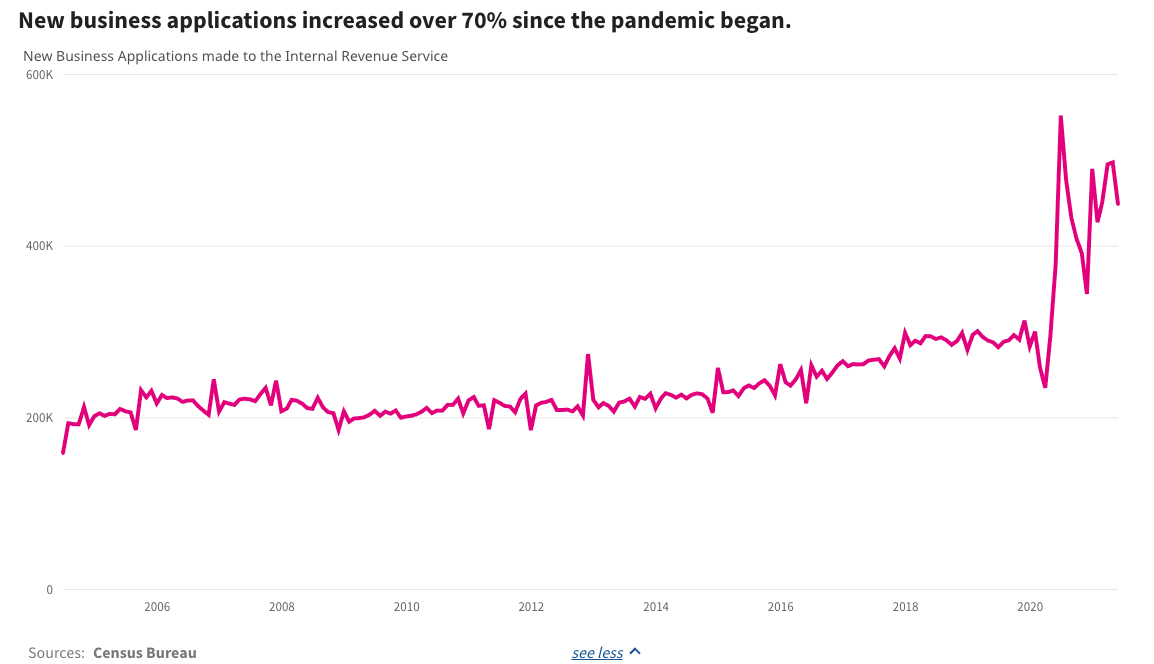If you’re reading this…you’re right on time.
There’s literally never been a greater need for freelance writers and content creators. Established brands are pouring billions of dollars into whatever the metaverse is or will be. New business applications hit an all-time high in 2020 according to the National Bureau of Economic Research, and 90% are small businesses. This means they’re starting from a blank canvas!

So, strike while the iron is hot 🔥 ! Here’s a crash course for how to get started as a freelance writer, including pitfalls to avoid.
The 9 Steps to Becoming a Freelance Writer
- Set a goal
- Adopt the right skills & mindset
- Make a list of 20 potential clients
- Start pitching
- Pricing your work
- Setting terms & signing contracts
- Write, write, write!
- Send invoices & get paid
- Growing and marketing your services
_____________________________________________________________________
1. Set a goal
For now, start with a modest goal but make it SMART: Specific, Measurable, Achievable, Realistic and Time-based. Take a moment to define and write this down. Some ideas for goals, from least to most ambitious:
- Send 20 pitches a week for 1 month
- Gain three new clients by this time next month
- Land two pro bono projects to start your portfolio
- Earn $2,000/month from at least 1 client, in the next 3 months
- Sign a retainer client for $7,000/month for 6 months (💸!)
2. Adopt the right skills & mindset
At the very least, you need a strong grasp of language, empathy for your audience and the ability to write in a brand’s particular style to become a successful freelance writer. See Step #7 of this article for writing resources.
Otherwise, some helpful bits of advice include:
- Your time will be split between writing and running a business — This comes as a shock to newbies, but when starting out you’ll spend about 50% of your time on marketing and admin tasks like pitching ideas, drafting agreements, managing projects, submitting invoices and tracking expenses.
- Take yourself seriously — This includes announcing your new path to friends and family. But be selective; some may envy your ambition, or give you reasons to not pursue such an independent course. Tell your biggest cheerleaders you may need to send them drafts for feedback in the future, or ask for words of encouragement once in a while.
- Mistakes are research — You might undersell your services at first or focus on a niche you outgrow. This is all valuable experience as you become a savvier freelancer.
- You don’t need a portfolio to start — A well-crafted email and LinkedIn profile can land a conversation, especially if your target is a busy small business owner. If they ask for a sample, offer to write one just for them.
- It’s OK to change your niche — You might not even have a niche! Some writers focus on content type, versus topic or industry. For instance, social copywriting vs. video scripts.
3. Finding your first few clients
When you’re just breaking into the game, you’ve got to start on the ground and move up gradually. Gather a list of 20 potential clients from a few key places:
- Friends’ businesses — Offer to take over their social media for a month, write a killer “About” page, or launch a newsletter. That’s three samples, easy peasy.
- Previous employers — Let them know you’re freelancing and see if they need anything written.
- Local nonprofits — Is there a cause you care about? Search for local nonprofits and offer ideas for blog posts. Odds are they’re strapped for resources and could use extra help.
- Local businesses — Think of your favorite local spots that already know you. Maybe it’s your favorite coffee shop, or the restaurant that just opened and doesn’t even have a website yet.
- Chamber of commerce websites — These directories of local businesses are arranged by category, and include their website and contact info. Happy digging!
4. Start pitching
The goal here is to start conversations. First dates, not marriage proposals. A bit of research goes a long way, so get to know each company on your list and what they are currently doing online. Keep it short and sweet, introduce yourself as a customer or a fan, and offer your services as a freelance writer.
Until you have a few responses, repeat this step.
5. Pricing your work
At the start of your freelance career, it’s okay to start on the low end and raise your rates as you gain more clients. Especially if your goal is to gain experience and build confidence.
That said, here are some pricing suggestions:
- Blog posts — $50 to $1000. This varies by experience and expertise.
- Social profile setup — $500 for solid “About” copy.
- Product pages — $100 to $250 per page with copy describing each product.
- Small website — $3,000 to $7,000 for a site with a few key pages.
- Newsletters — $250 to $1200 per email. Just one newsletter client can be a steady source of income!
For more information on pricing projects, check out AWAI’s 2021 Copywriting Pricing Guide.
6. Setting terms & signing contracts
Once your proposal has been accepted, put it in writing. This can be an email stating your deliverables, deadlines, cost of services (as an hourly rate or defined per project), and your method of payment, like online transfer or check. Some writers charge a deposit of 30-50% before the project starts, especially for bigger clients. You can also include how many rounds of revisions are included for each project. It’s critical to have both parties agree to this before work begins for alignment.
7. Write, write, write!
Finally! We’ll keep this section brief with just a few additional resources depending on the type of writing you’re doing:
- Ultimate Guide to Types of Freelance Writing Projects — with skills for each.
- Copyblogger — advice from a leading web copywriter, Brian Clark.
- AWAI — one of the larger copywriter training organizations out there.
- Moz’s Beginner’s Guide to SEO — a crash course on a valuable topic.
- Neil Patel — training on all things digital marketing, including copywriting that sells.
8. Sending invoices & getting paid
Based on the terms from Step #6, this should be straightforward. Invoices can be as simple as a Google doc with an ID number (starting at 1), your name and contact info, a brief description of your services and cost, and payment information like your bank routing number.
9. Growing and marketing your services
Once you’ve done some small projects, it’s time to catch bigger fish. The best ways to do so include:
- Referrals — The easiest path to new business is happy clients. After you complete a project, ask if your client knows anyone who could use your services.
- LinkedIn — Update your bio with a description of your services and links to completed projects.
- Portfolio website — This step actually requires ongoing work, as it’s important to update your portfolio with recent projects. Slowly, you’ll build a body of work that reflects the version of yourself you’re becoming, and your favorite type of project and client. Plus, having a regularly-updated website that showcases your work can even attract new clients to your freelance writing business from Google!
We’ll dive deeper into each topic in future posts, so stay tuned. Until then, start pitching!




